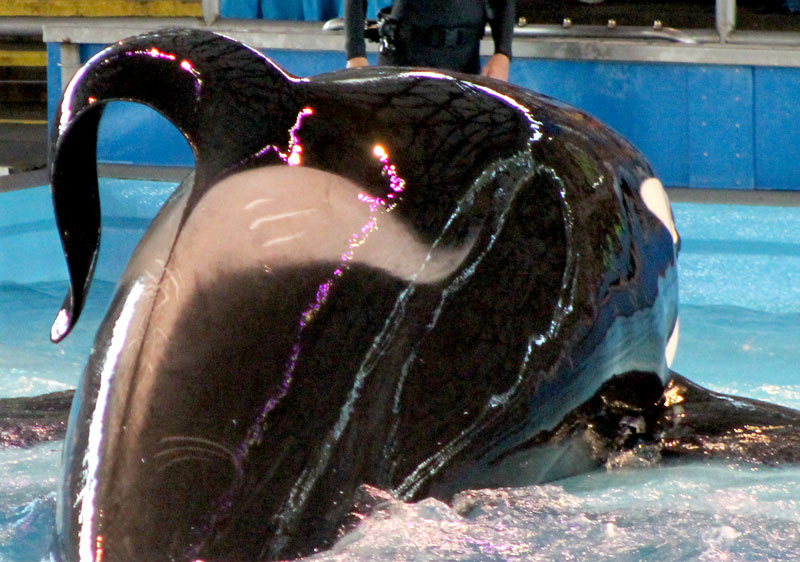Why You Should Avoid Visiting Marine Mammal Parks: The cruelty behind dolphins in captivity
May 8, 2020
Dolphin and killer whale shows have been a popular attraction for aquariums and marine animal theme parks for decades. However, what many guests don’t realize is how unhappy the performers of these shows truly are. The tickets purchased to view these beautiful creatures may be doing more harm than is realized. Dolphins are known to be extremely intelligent creatures, bottlenose dolphins and orcas in particular. Although these mammals may seem to be happy to perform for the public, the truth behind their lives in captivity may change your opinion of the impressive shows that parks advertise to the world.
Killer whales’ deterioration of health and happiness within captivity is the most alarming of all whale species. Killer whales are extremely social creatures who remain with the same pod from birth to death. These pods each develop their own language which they use to communicate with each other across long distances. A mother whale develops a strong bond with her calf from birth, and they maintain that connection throughout life. Orca whales are known to swim up to 100 miles a day in the wild, crossing vast distances in open waters. These animals are powerful, social, and incredibly intelligent.
Their time in captivity ruins every chance of these creatures being able to live the free life they deserve. The first-ever orca capture occurred in 1961, an orca named Wanda. Since then, dozens of other orca calves have been violently ripped from their pods with the use of explosives and stressful separation tactics. In the well-known documentary Blackfish, there is footage of the process used to capture a wild orca, and it is revolting. Separated from their pods and transported vast distances, the whales become extremely stressed and their unhappiness heightens when they’re placed in small, chemically-treated tanks.
Though they usually seem pleasant in shows, what’s truly going on evades the usual guest’s awareness. The most tell-tale sign of what these whales endure is the fact that 100% of captive male killer whales and many females sport a flopped-over dorsal fin, which rarely occurs in the wild. Captive orcas also are often spotted gnawing at the concrete walls of their tanks, which causes wearing, cracking, and loss of teeth. This is an extremely common issue, where humans have to go in and drill the teeth so they don’t get infected. Though many teeth are damaged or lost due to this behavior, whale on whale aggression still causes severe damage. Although killer whales are extremely social, often the stress these whales are put in and the difficulty of whales from separate pods to communicate with varying languages can cause issues. Whales who were placed together in artificial pods often display a behavior called “raking” which entails one whale digging their teeth into a fellow whale’s flesh, occasionally drawing blood.
However, the most severe issue by far is the fact that whales in captivity have been known to kill. Blackfish, which I mentioned previously, tells the story of a large male orca named Tilikum who caused the deaths of three individuals throughout his lifetime in captivity. From the moment he was ripped from the wild by captors, he experienced cruelty and violence at the hands of humans. His original holding was at a small park called Sealand. Here, Tilikum resided with two older female orcas, who raked and harmed him constantly. During the day, the three whales swam about in a small pool with hardly any entertainment, and by night were locked up in a small steel box together to prevent people from setting them loose. Due to the stressful environment, Tilikum endured raking nightly by the two superior females he was kept with. This was largely the result of trainers at this ramshackle park using a tactic where they refused to give the whales food unless they obeyed, causing the whales to become hungry and aggressive. It was at this park where Tilikum killed his first victim. The park later closed, and Tilikum was sold to Seaworld, where he caused two more deaths and was used to create future generations of captive killer whales.
Luckily, when Blackfish came out to the public, it roused severe backlash against large theme parks who held orca whales in captivity. Since then, most parks no longer allow their trainers in the water with these mammals as they used to, and Seaworld has stopped breeding their whales, meaning many parks and aquariums are likely on their last generations of captive whales. Despite this, you may want to consider avoiding these shows, as what really goes on behind them is not what it seems.

Photo Credit: seaworldofhurt.com




